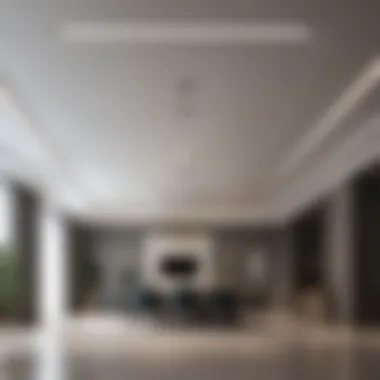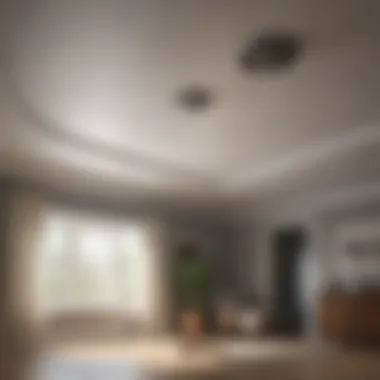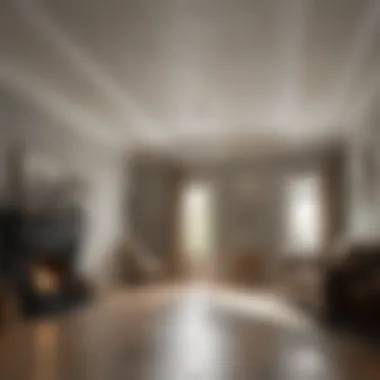Upgrade Your Ceiling with This Detailed Popcorn Ceiling Removal Guide


Interior Design Tips
When it comes to revamping your ceiling by removing popcorn texture, it's crucial to consider the overall interior design of your space. Removing the dated ceiling texture can significantly impact the look and feel of a room, creating a more modern and sleek aesthetic. Trendy design ideas may involve opting for smooth ceiling finishes instead of textured ones, as smooth ceilings are currently a popular choice among homeowners seeking a contemporary look.
Color schemes and combinations play a vital role in enhancing the newly revamped ceiling. Choosing the right color palette can complement the smooth finish, tying the room together seamlessly. Neutral tones like whites, beiges, or light grays can help create an open and spacious feel. Furniture arrangement techniques should also be considered to maximize the impact of the updated ceiling, ensuring that the furniture layout complements the modern aesthetic and allows the smooth ceiling to be the focal point of the room.
Introduction
Popcorn ceilings, once a popular choice in interior design, are now considered outdated and unattractive. In this comprehensive guide on revamping your ceiling, we delve into the detailed process of removing popcorn textures to achieve a more modern and sleek finish for your space. Bid farewell to the textured ceilings of the past and welcome a fresh look for your home.
Understanding Popcorn Ceilings
Composition of Popcorn Ceilings
Popcorn ceilings, also known as acoustic ceilings, are typically made of a mixture of drywall mud or joint compound and styrofoam-like material. This composition results in a textured surface that helps with soundproofing and hides imperfections. While popular in the past, the rough texture can accumulate dust and be challenging to clean or paint, prompting the need for removal to update the aesthetic appeal of a room.
Reasons for Removing Popcorn Ceilings
The decision to remove popcorn ceilings is driven by several factors. Firstly, the outdated look of popcorn textures can diminish the overall aesthetics of a room, creating a dated appearance. Additionally, the textured surface may contain asbestos in older homes, posing health risks if disturbed. By eliminating popcorn ceilings, homeowners can enhance the visual appeal of their living spaces and mitigate potential health concerns associated with these textures.
Benefits of Removing Popcorn Ceilings
Enhanced Aesthetics
One of the primary benefits of removing popcorn ceilings is the immediate aesthetic improvement it brings to a room. Smooth ceilings provide a modern and streamlined look, reflecting light more evenly and making the space appear larger and airier. Eliminating the textured surface allows for endless ceiling design possibilities, from painted finishes to decorative treatments, transforming the room into a sophisticated and updated living area.
Health Considerations
Apart from the visual aspect, health considerations play a crucial role in the decision to remove popcorn ceilings. As mentioned earlier, older popcorn ceilings may contain traces of asbestos, a hazardous material linked to respiratory issues and cancer. By eliminating these outdated textures, homeowners can create a healthier indoor environment for their families, reducing the risk of exposure to harmful substances and promoting overall well-being.


Preparation
In the realm of renovating your living space, preparation stands as the essential cornerstone, laying the groundwork for a successful transformation. It's not just about rolling up your sleeves; it's about meticulous planning and readiness. In the context of removing popcorn ceilings, preparation can make a world of difference in the outcome.
Gathering Materials
Protective Gear
When embarking on the journey of transforming your outdated ceiling, equipping yourself with the right protective gear is paramount. Be it safety goggles, masks, gloves, or coveralls, each piece serves a crucial role in safeguarding yourself from potential hazards like dust particles, chemicals, or physical injuries. Opting for high-quality, durable protective gear ensures not only your safety but also enhances the efficiency of the task at hand.
Tools and Equipment
In the realm of ceiling revamping, having the proper tools and equipment can significantly streamline the process. From scrapers and sanders to ladders and paintbrushes, each tool plays a crucial part in achieving a seamless finish. Choosing tools known for their durability and ergonomic design can make the removal of popcorn ceilings a more manageable feat.
Prepping the Room
Furniture Removal
Parting ways with your furniture temporarily might seem cumbersome, but it is a necessary step in preparing the room for the transformation ahead. By clearing the space of obstacles, you not only create a safer working environment but also allow for unrestricted access to the ceiling. Storing furniture in a separate area protects your belongings from potential damage during the renovation process.
Floor Protection
As we delve deeper into the prepping phase, ensuring proper floor protection emerges as a pivotal task. Covering the floor with durable materials like drop cloths or plastic sheeting shields it from potential debris, scratches, or spills. This simple yet crucial step not only safeguards your flooring but also expedites the post-renovation clean-up process, ensuring a hassle-free experience.
Removing the Popcorn Texture
When considering a home renovation project, one crucial aspect that often gets overlooked is removing the popcorn texture from the ceiling. This step is essential in achieving a more modern and sleek look for your living space. By eliminating the outdated popcorn ceiling, you can significantly enhance the aesthetics of the room and create a cleaner, more sophisticated atmosphere. Additionally, removing the popcorn texture is essential for health reasons as these ceilings can harbor dust, debris, and even mold, posing potential risks to respiratory health. In this section, we will delve into the detailed process of scraping techniques and repairing imperfections, equipping you with the knowledge and tools needed for a successful ceiling renovation.
Scraping Techniques
Wet Scrape Method


The Wet Scrape Method involves misting the popcorn texture with water to soften it before gently scraping it off. This technique is a popular choice for this article due to its effectiveness in minimizing dust and debris during the removal process. By moistening the texture, it becomes easier to scrape off without creating a cloud of particles that can linger in the air. The key characteristic of the Wet Scrape Method lies in its ability to create a cleaner and more controlled removal process, ensuring a more efficient and less messy operation. The unique feature of this method is its environmentally friendly approach, reducing the dispersal of potentially harmful particles into the surrounding environment. While the Wet Scrape Method is generally a preferred technique for removing popcorn ceilings, it may require more time than dry scraping due to the initial wetting process.
Dry Scrape Method
Contrary to the Wet Scrape Method, the Dry Scrape Method involves scraping the popcorn texture off the ceiling without any prior moistening. This technique is favored by some for its straightforward and quick application, making it a viable choice for those seeking a faster removal process. The key characteristic of the Dry Scrape Method is its time efficiency, allowing homeowners to tackle the project in a more expedited manner compared to wet scraping. However, it is essential to note that dry scraping can generate more dust and debris compared to wet scraping, potentially leading to a messier clean-up process. Despite its quicker pace, the Dry Scrape Method may result in a more labor-intensive post-removal cleaning routine to ensure all particles are properly cleared. It is essential to assess the specific needs of your project and choose the scraping technique that aligns best with your timeline and cleanliness preferences.
Repairing Imperfections
After successfully removing the popcorn texture from the ceiling, the next step involves repairing imperfections to ensure a smooth and flawless finish. This stage is crucial in achieving a polished look for your ceiling, concealing any gaps, cracks, or uneven surfaces left behind by the removal process. In this section, we will explore filling gaps and cracks and sanding for smoothness, detailing the steps needed to perfect your ceiling renovation.
Filling Gaps and Cracks
Addressing any gaps and cracks in the ceiling is vital for creating a seamless appearance post-popcorn removal. The Filling Gaps and Cracks process involves using a suitable filler material to patch up any areas where the texture may have caused damage or unevenness. This step is a beneficial choice for this article as it ensures that the ceiling's surface is uniform and free of blemishes. The key characteristic of Filling Gaps and Cracks is its ability to provide a solid foundation for the final finish, minimizing the visibility of imperfections and creating a cohesive look throughout the room. The unique feature of this process is its customization, allowing homeowners to tailor the filler material to match the ceiling's texture and color seamlessly. While Filling Gaps and Cracks is essential for a flawless end result, it requires attention to detail and precision to achieve a professional-quality finish.
Sanding for Smoothness
Once any gaps and cracks have been filled, the next step is sanding for smoothness to refine the ceiling surface further. Sanding plays a crucial role in creating a uniform and velvety texture, preparing the ceiling for priming and painting. The key characteristic of Sanding for Smoothness is its ability to eliminate rough patches and uneven areas, resulting in a polished and pristine appearance. This technique is a preferred choice for this article as it enhances the overall aesthetics of the ceiling, ensuring a smooth canvas for the final finish. The unique feature of sanding lies in its ability to smooth out imperfections and create a seamless transition between the patched areas and the existing ceiling surface. While Sanding for Smoothness is crucial for achieving a flawless outcome, it requires patience and precision to achieve the desired level of smoothness and consistency.
Finishing Touches
In the quest for a flawless ceiling transformation, 'Finishing Touches' play a pivotal role in achieving a pristine and modern ceiling aesthetic. As this guide on removing popcorn ceilings progresses towards its conclusive stages, the emphasis shifts towards the crucial aspect of providing the ideal finish to your renewed ceiling surface. The execution of these finishing touches not only enhances the visual appeal of the room but also ensures a long-lasting and durable ceiling solution. By focusing on the finer details during this phase, homeowners can truly elevate the overall look and ambiance of their living spaces. From priming the surface to choosing the right paint and executing the final painting techniques, the section of 'Finishing Touches' encapsulates the essence of the entire renovation process, bringing forth a renewed and refined ceiling structure.
Priming the Surface
Importance of Primer
At the core of the 'Priming the Surface' step lies the indispensable role of primer in ensuring a successful and long-lasting ceiling renovation. Primer acts as the foundation for the paint application, facilitating adhesion and creating a uniform surface for flawless paint coverage. The key characteristic of primer lies in its ability to seal porous surfaces, promote paint durability, and enhance paint adherence, effectively preventing paint peeling and promoting a smoother finish. In this article, the emphasis on primer underscores its status as an essential preparatory step before painting, serving as a protective barrier that enhances the overall longevity and aesthetic appeal of the newly refinished ceiling. The unique feature of primer lies in its versatility, catering to various surface types and enhancing the durability and vibrancy of the applied paint. While primer offers remarkable benefits in terms of paint adhesion and surface protection, its main disadvantage may lie in the additional time and effort required for application, yet the benefits far outweigh the minor inconveniences, making primer a popular and advantageous choice for achieving a flawless ceiling finish.
Application Techniques


Delving deeper into the process of 'Priming the Surface,' the discussion now turns to the diversified range of application techniques that contribute significantly to the overall success of the ceiling refurbishment project. Effective application techniques involve strategic priming methods that ensure even coverage, proper absorption, and optimal adhesion to guarantee a seamless painting process. The key characteristic of these techniques lies in their ability to enhance the protective properties of the primer, creating a robust foundation for the subsequent paint layers. By selecting and implementing the appropriate application technique, homeowners can expedite the priming process, optimize paint performance, and elevate the visual impact of the final painted surface. The unique feature of these application techniques lies in their adaptability to different surfaces, textures, and environmental conditions, offering versatility and precision in achieving an impeccable primer application. While some application techniques may require specific equipment or professional expertise, their advantages in enhancing paint durability, coverage, and overall finish are unparalleled, making them an indispensable component of the ceiling renovation process.
Painting the Ceiling
Choosing the Right Paint
When it comes to 'Painting the Ceiling,' selecting the right paint is a critical decision that significantly influences the overall quality and longevity of the ceiling finish. The importance of choosing the right paint lies in its ability to withstand potential wear and tear, resist moisture, and complement the interior decor of the space. The key characteristic of the ideal ceiling paint resides in its durable and washable properties, ensuring long-term color retention and easy maintenance. In this article, the focus on selecting appropriate ceiling paint underscores its role in achieving a professional and polished finish that revitalizes the room ambiance. The unique feature of the right ceiling paint is its diverse range of finishes and formulations, catering to different aesthetic preferences and functional requirements. While certain paints may offer specific advantages such as mold resistance or low odor, homeowners must also consider factors like coverage, sheen, and ease of application when choosing the most suitable paint for their ceiling renovation project.
Execution Tips
As the ceiling renovation journey culminates in the 'Execution Tips' phase of painting, attention shifts towards implementing best practices and techniques for a seamless and successful paint application. The key characteristic of execution tips lies in their ability to optimize paint coverage, minimize drips and streaks, and ensure a uniform and professional-looking finish. By following these tips diligently, homeowners can navigate the painting process with confidence, achieving consistent color distribution and surface smoothness. The unique feature of these tips is their practicality and efficiency in addressing common painting challenges, such as brush or roller marks, color variations, and drying times, ultimately leading to a flawless and aesthetically pleasing result. While execution tips may require patience, precision, and attention to detail, their advantages in streamlining the painting process and enhancing the overall quality of the painted ceiling are invaluable, positioning them as indispensable guidelines for a successful ceiling renovation.
Aftercare and Clean-Up
After removing the popcorn texture from your ceiling, it's crucial to pay attention to aftercare and clean-up to ensure a flawless finish. The aftercare process involves inspecting for residue and restoring the room to its original state. By carefully examining the ceiling for any lingering texture and thoroughly cleaning the surfaces, you can achieve a polished look that enhances the overall aesthetics of the room.
Inspecting for Residue
Checking for Lingering Texture
Checking for lingering texture is a critical step in the aftercare process. This involves running your hands over the ceiling surface to feel for any rough patches or remaining popcorn texture. By detecting and addressing any residues promptly, you can ensure a smooth and even ceiling that is free of imperfections. This meticulous inspection guarantees that the removal process was thorough and that the desired result of a modern, textured ceiling is achieved.
Cleaning Surfaces
Cleaning the surfaces post-popcorn ceiling removal is essential for a pristine finish. Using a damp cloth or sponge, wipe down the ceiling to remove any dust, debris, or residual texture. This cleaning step not only enhances the appearance of the ceiling but also sets the stage for the next phase of restoration. By maintaining cleanliness, you create a suitable canvas for any further treatments or decorations, ensuring the longevity and quality of your revamped ceiling.
Restoring the Room
Once the inspection and cleaning are complete, the final step in the aftercare process is restoring the room to its pre-renovation state. This includes putting back any furniture that was removed before the project began and adding final touches to complete the transformation. By carefully replacing furniture in its original position and adding personal decorative elements, you can bring new life to the space and showcase the updated ceiling as a focal point.
Replacing Furniture
Replacing furniture is not just about functionality but also contributes to the visual appeal of the room. By strategically arranging furniture pieces, you can enhance the flow of the space and complement the new ceiling design. Choose pieces that harmonize with the updated aesthetic, creating a cohesive and balanced ambiance that ties the room together.
Final Touches
The final touches are the finishing strokes that elevate the room's overall look. Whether it's adding decorative accents, artwork, or lighting fixtures, these details play a crucial role in enhancing the revamped ceiling. Pay attention to color schemes, textures, and arrangement to create a harmonious and inviting atmosphere that reflects your style and personality. By focusing on these little details, you can truly transform your space and admire the impressive results of your popcorn ceiling removal project.







